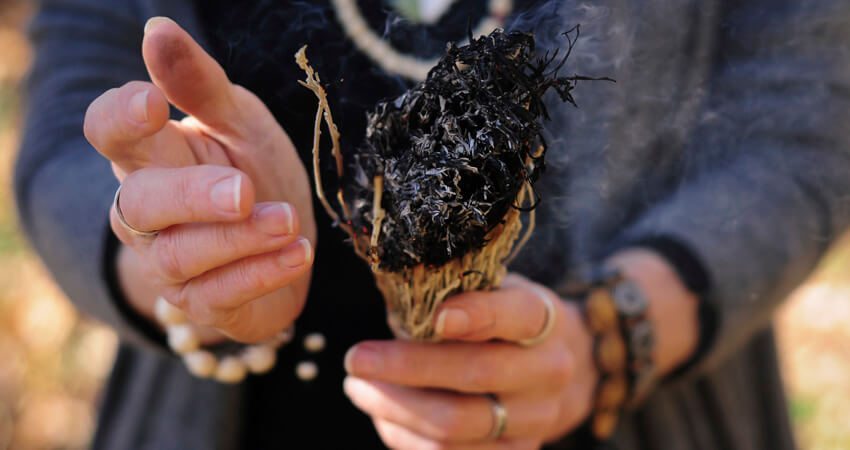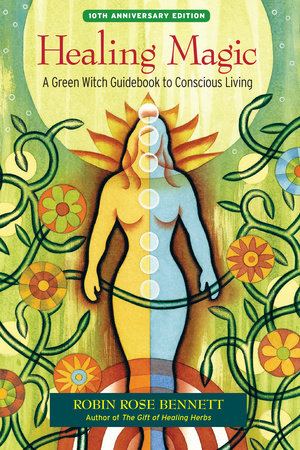Now that we have entered into a new year, it’s the perfect time to cleanse our homes, minds, and hearts of the residual negative energies of the past year. Much like a bath for the body, smudging is an effective way to cleanse these sacred spaces of psychic pain and a good exercise to balancing your chakras.
For advice on smudging and healing smoke, we turned to Robin Rose Bennett. Her book Healing Magic is an excellent resource on choosing the right herbs for the right time. Spirituality and Health also has a great article on The Ancient Art of Smudging which provides an overview on how you can approach this ancient practice with reverence and respect.
Here is an excerpt from Robin Rose Bennett’s Healing Magic, followed by a list of the many helpful gifts offered by each of the plants mentioned below:
People everywhere on Earth burn local plants that are resinous and/or high in volatile oils in their ceremonies, rituals, and religious or spiritual gatherings. These fragrant plants are called aromatics, and are prized for their consciousness-changing qualities, especially when burned as smudge. Smudge is a term used for sacred smoke. It is akin to specially charged incense. Herbs can also be smoked in a sacred manner in a pipe.
Smoke, in this as in most Earth-based traditions, is used both to create sacred space and to communicate with Spirit. It is a way of sending out prayers and giving thanks. Think of the smoke as making your thoughts and intentions visible as they’re being sent out to Spirit. You draw energy to yourself, as well, by means of the smoke signals. Smoke from plants is traditionally used to bring in what you consider desirable and to cast out what you don’t want, whatever you find unacceptable or harmful.
Leaves and flowers (dried only) can be burned without charcoal, directly in an abalone shell, clay pot, or cauldron. Resins and powders are burned on flat-topped, round pieces of charcoal that are usually available in herb stores and street markets where the herbs are sold. (Store charcoal in moisture-proof containers.)
First, light an edge of the charcoal in a clay dish or any fireproof container. When it is lit—you will know because it will start to spark—place the herbs on it. A feather can be used to spread the smoke through the air, whether directing it to the elements, or around altar objects, or to smudge a person by wafting the smoke all around him or her with care.
Smudge sticks are easy to use, too, and are commonly available for purchase. The “sticks” are actually leafy stalks that are dried and then bundled and tied together into a cigar shape. One “tip” is lit and the other end is held.
You can also make smudge sticks of any diameter and length by rolling up a bundle of flowering stalks snugly in a large sheet of newspaper. Secure the roll tightly with rubber bands, and remove the paper when you’re ready to use the smudge stick. Before or after rolling up the herbs to dry, tie the bundle together using any color of cotton thread.
I usually prefer to use smudge sticks outdoors rather than indoors, because they tend to create a lot of smoke.
Whatever you are burning, when smudging indoors, open a window, at least for a moment, because as old energies are released, they need to be able to leave the room, and as beneficial energies are being invoked, they will be able to come to you more easily. It also helps your prayers, visions, intentions, and expressions of gratitude to travel up, down, and out beyond your immediate circle.
Plants that are wild and local to the Northeast United States, such as mugwort/cronewort (Artemisia vulgaris), white and yellow sweet clovers (Melilotus albus and Melilotus officinalis), and northern white cedar (Thuja occidentalis) are ones that I like to gather, dry, and use frequently as smudge herbs.
I also grow lavender (Lavandula species) in my garden. The stalks and the flowers of any of the lavenders make a sweet, enchanting smoke. I like white sage (Artemisia tridentata) very much. I also find it the easiest plant to keep lit once I get it burning. Being native to the desert, sage grows wild in vacant lots in Los Angeles (according to my friends who live out there). I plant it in my garden in the spring to harvest in the fall.

